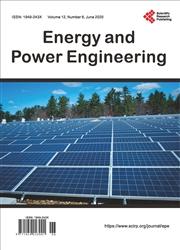Optimal Allocation of a Hybrid Wind Energy-Fuel Cell System Using Different Optimization Techniques in the Egyptian Distribution Network
引用次数: 3
Abstract
This paper presents an optimal proposed allocating procedure for hybrid wind energy combined with proton exchange membrane fuel cell (WE/PEMFC) system to improve the operation performance of the electrical distribution system (EDS). Egypt has an excellent wind regime with wind speeds of about 10 m/s at many areas. The disadvantage of wind energy is its seasonal variations. So, if wind power is to supply a significant portion of the demand, either backup power or electrical energy storage (EES) system is needed to ensure that loads will be supplied in reliable way. So, the hybrid WE/PEMFC system is designed to completely supply a part of the Egyptian distribution system, in attempt to isolate it from the grid. However, the optimal allocation of the hybrid units is obtained, in order to enhance their benefits in the distribution networks. The critical buses that are necessary to install the hybrid WE/ PEMFC system, are chosen using sensitivity analysis. Then, the binary Crow search algorithm (BCSA), discrete Jaya algorithm (DJA) and binary particle swarm optimization (BPSO) techniques are proposed to determine the optimal operation of power systems using single and multi-objective functions (SOF/MOF). Then, the results of the three optimization techniques are compared with each other. Three sensitivity factors are employed in this paper, which are voltage sensitivity factor (VSF), active losses sensitivity factor (ALSF) and reactive losses sensitivity factor (RLSF). The effects of the sensitivity factors (SFs) on the SOF/MOF are studied. The improvement of voltage profile and minimizing active and reactive power losses of the EDS are considered as objective functions. Backward/forward sweep (BFS) method is used for the load flow calculations. The system load demand is predicted up to year 2022 for Mersi-Matrouh City as a part of Egyptian distribution network, and the design of the hybrid WE/PEMFC system is applied. The PEMFC system is designed considering simplified mathematical expressions. The economics of operation of both WE and PEMFC system are also presented. The results prove the capability of the proposed procedure to find the optimal allocation for the hybrid WE/PEMFC system to improve the system voltage profile and to minimize both active and reactive power losses for the EDS of Mersi-Matrough City.埃及配电网中采用不同优化技术的风能-燃料电池混合系统优化配置
为了提高配电系统的运行性能,提出了一种混合风能与质子交换膜燃料电池(WE/PEMFC)系统的优化分配方案。埃及的风力非常好,许多地区的风速约为10米/秒。风能的缺点是它的季节变化。因此,如果风力发电要满足很大一部分需求,则需要备用电源或电力储能系统来确保负荷的可靠供应。因此,混合WE/PEMFC系统被设计为完全供应埃及配电系统的一部分,试图将其与电网隔离开来。为了提高混合机组在配电网中的效益,必须对混合机组进行优化配置。使用灵敏度分析选择安装WE/ PEMFC混合系统所需的关键母线。然后,提出了二元Crow搜索算法(BCSA)、离散Jaya算法(DJA)和二元粒子群优化(BPSO)技术,利用单目标和多目标函数(SOF/MOF)确定电力系统的最优运行。然后,对三种优化方法的结果进行了比较。本文采用电压敏感因子(VSF)、有功损耗敏感因子(ALSF)和无功损耗敏感因子(RLSF)三种灵敏度因子。研究了灵敏度因子(SFs)对sofof /MOF的影响。以改善电压分布和减小有功、无功损耗为目标函数。负荷流计算采用后向/前向扫描(BFS)方法。作为埃及配电网的一部分,Mersi-Matrouh市的系统负荷需求预计将持续到2022年,并采用WE/PEMFC混合系统的设计。PEMFC系统的设计考虑了简化的数学表达式。并对WE系统和PEMFC系统的运行经济性进行了分析。结果表明,所提出的方法能够找到混合WE/PEMFC系统的最佳配置,以改善系统电压分布,并使Mersi-Matrough市EDS的有功和无功损失最小化。
本文章由计算机程序翻译,如有差异,请以英文原文为准。
求助全文
约1分钟内获得全文
求助全文

 求助内容:
求助内容: 应助结果提醒方式:
应助结果提醒方式:


